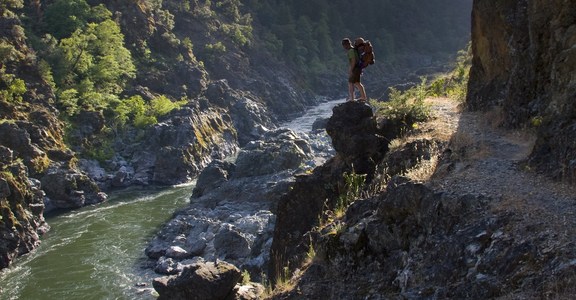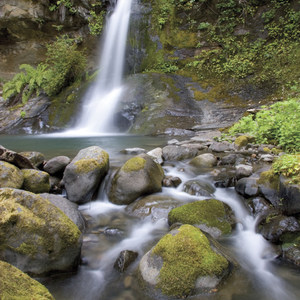Middle Fork Hiking Trail - Overview Info
The Middle Fork of the Salmon Trail parallels the river from Boundary Creek (RM 0) to the Big Creek Bridge (RM 77.8). Side canyon trails join the main system in many spots, and at times there are trails on both sides of the Middle Fork. Miles indicated in the title and throughout the text use river miles (RM). Though the trail covers more linear distance, the best map labels mileage in reference to floating the river corridor.
These descriptions are from a raft-supported Middle Fork hiking trip and are intended to provide a description of a typical day along the entire length of the Middle Fork Trail. While this trip is easily accomplished with raft support, backpackers will be carrying considerably more weight and will have to come up with a different plan for egress from the canyon. One option would be to charter a flight out of the canyon from the Flying B Ranch (RM 66.5). Alternately, one can hike out through either Big Creek (river left) or the Big Horn Crags (river right) once the trail leaves the Middle Fork at the Big Creek Bridge (RM 77.8).
In addition, backpackers will have more flexibility with their campsite selection and itinerary as they are not assigned specific campsites along the river. For more information about permits and wilderness regulations visit the Middle Fork Ranger District website.
For more general information about rafting the Middle Fork of the Salmon read this informative Middle Fork overview.
To avoid redundancy, these hiking descriptions focus on the particulars about the trail/hiking experience. Additional Outdoor Project adventures covering each day of a six-day Middle Fork float that include a detailed landscape description can be found here:
Middle Fork of the Salmon River – Day 1 - Boundary Creek Launch (RM 0) to Sheepeater Camp (RM 13.3)
Middle Fork of the Salmon River – Day 2 - Sheepeater Camp (RM 13) to Marble Creek Camp (RM 32.4)
Middle Fork of the Salmon River – Day 3 - Marble Creek Camp (RM 32.4) to Shelf Camp (RM 48.9)
Middle Fork of the Salmon River – Day 4 - Shelf Camp (RM 48.9) to Driftwood Camp (RM 71.6)
Middle Fork of the Salmon River – Day 5 - Driftwood Camp (RM 71.6) to Otter Bar Camp (RM 90.5)
Day 5 - Big Loon Camp (RM 50.1) to Cave Camp (RM 52.6)
From the camp at Big Loon the trail stays along the edge of broad fan/terrace that holds the airstrip. Continue downstream through a gate marking the edge of the Loon Creek Ranch property. Not much further the trail splits with one branch leading down to Cow Camp (RM 50.7) while the other traverses the hillside above the camp. After passing beneath two cool red granite towers (scramble to the top of the first for a wonderful view upstream), the trail hugs the very edge of a narrow terrace about 40 feet above the river. Just as Underwater Canyon Rapid comes into view, the trail moves back from the edge.
Adventurous swimmers who want to take the time can scramble down to the river and explore the cool bedrock channels below Underwater Canyon. At slower August flows, it is possible to swim the entire length of the several hundred yard long channel.
The next 1.5 miles to Cave Camp (RM 52.6) is a pleasant walk beneath steep north-facing chutes and across an open grassy hillside to the sharp turn above Cave Camp. This infrequently used camp is a nice option for backpackers who don’t mind the easy swim across to the Hospital Bar Hot Springs.
Cave Camp (RM 52.6) to Upper Grouse Camp (RM 56.8)
The trail crosses beneath another steep, forested north-facing hillside as it rounds the corner opposite Hospital Bar. After crossing Big Aparejo Creek (RM 53.5) it traverses out in the midst of a sheer north face that is one of the coolest sections of trail along the river. The impressive path weaves beneath and along several grassy cliff bands to a high point about 200 feet above the river, and you'll enjoy great views in both directions before descending to a perch above the Cub Creek Waves (RM 54).
Cub Creek marks the beginning of three big, sweeping turns through the rugged canyons of the Grouse Necks. As the river weaves through 180-degrees of compass orientation, the character of the trail alternates between steep north-facing hillsides and mellower open grassy slopes. There are few trees to block the panoramic views in all directions. Once the canyon opens again, it is possible to drop down to the narrow sand bars among the willows at Upper Grouse Camp.
Upper Grouse Camp (RM 56.8) to Camas Creek (RM 60.3)
Hikers have two options when they are ready to continue downstream. The higher trail crosses the hillsides above both Upper and Lower Grouse Creek camps but avoids the cool historical stop at the Tappan Ranch Cabin. For those interested in river history, stay low and wander through the camps downstream to the cabin. A small bridge crosses Grouse Creek to explore the old orchards on the opposite side. Feeder trails climb downstream to re-join the main river trail.
Daisy Paulson grew up on the river with her grandparents at the Pistol Creek Ranch (RM 22.8) upstream. She returned to the river just like her brother Fred Paulson, who worked as a packer for various mines in the area. She and her husband Fred Tappan bought the ranch from Willis Bill Jones sometime in the thirties for $1,200. Jones had established a fruit orchard that was already bearing fruit.
Daisy and Fred expanded the ranch by diverting water from Grouse Creek to additional fruit trees, a large garden, and two hayfields behind the cabin. They had several head of cattle as well. The Tappans were almost entirely self-sufficient. Fred worked at the Yellowjacket Mine so they could afford to buy horseshoes, leather, and clothes.
When their boys were old enough to start school the Tappans moved closer to civilization. Daisy ran a dog sled for a mine near the town of Yellow Pine. She eventually settled in the Pahsimeroi Valley. Their ranch on the Middle Fork was arguably the most successful and reliably run homestead on the river.
Once past the Tappan Ranch (RM 57.1), the trail continues its dramatic journey into Tappan Canyon. Though the terrain is steep and nearly vertical in places, the route is well maintained, easy to follow, and offers an outstanding perspective looking down onto the rapids below. After skirting the very edge above Tappan I (RM 58.2), continue downstream for a good vantage onto Tappan Falls (RM 58.5) and stop to watch any passing boats run this drop. The next rapid, Cove Creek (RM 59), is situated at the base of a sheer grey cliff wall rising from the left bank. The steep walls continue for another half mile to Tappan IV (RM 59.3). Shortly downstream the canyon opens back up and the trail has to cross a long, hot, and dusty terrace to reach the bridge over Camas Creek.
Camas Creek (RM 56.8) to Trail Camp (RM 64.4)
There is a nice swimming hole in the creek a little below the bridge for a riverside picnic. A huge ponderosa tree also offers shade at the confluence with the Middle Fork where the main river campsite is located.
The final 6 miles to Trail Camp are less dramatic and cross long open terraces of waving grass and sage. The hiking can be hot, especially in the afternoon, but there are a few distractions to make it feel less like a slog. Pool Camp (RM 61.8) has a small sand bar right on the river with a deep swimming hole and great cliff jump from the left bank (this is a nice backpacker camp option as well). If you are hanging out at Pool Camp, it is worth looking for the spur trail that leads to Kaufman’s Cave at the base of the cliff above camp. A lone Scotsman named Clarence Kaufman built a wooden door to the cave and settled in for several years. He left to visit a doctor and never returned.
Downstream, the trail makes a mellow climb to a nice cliff overlook below Broken Oar Camp (RM 62.3) This is a nice place to rest and take in the view. Finally, the short but dramatic notch at Aparajo Rapid is another highlight. The river trail has been blasted out of the sheer canyon wall to avoid a several hundred-foot climb up and over narrow gorge. Below Aparajo it’s an easy downhill stroll into the sand bars among huge ponderosa pine trees at Trail Camp.
Previous Day – Middle Fork of the Salmon Trail – Day 4
Next Day – Middle Fork of the Salmon Trail – Day 6
Reference: Content partially excerpted from The Middle Fork of the Salmon River – A Comprehensive Guide by Idaho River Publications.
Logistics + Planning
Current Weather: Powered by Dark Sky







Preferable season(s)
Congestion
Parking Pass
Pros
Cons
Trailhead Elevation
Features
Suitable for
Our mission is to inspire adventure with beautiful, comprehensive and waterproof map-based guidebooks. Owner, publisher, and photographer Matt Leidecker, grew up exploring and guiding on the rivers in central Idaho. His award winning Middle Fork of the Salmon River – A Comprehensive Guide is the standard by which other river guidebooks are measured. Printed on virtually indestructible YUPO paper, IRP guides are truly unique all-in-one resources for adventure. Each book is loaded with full-color maps, stunning photographs, and information on the history, geology, and wildflowers. Visit Idaho River Publications to explore our guidebooks to the Rogue River in Oregon and the mountains of Central Idaho.


















Comments
Sign In and share them.